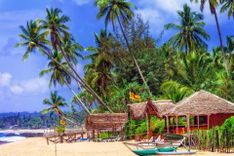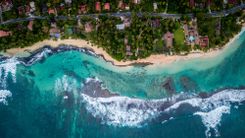10. Trincomalee Beach and Marble Beach
Trincomalee, on the northeast coast, is known for quiet, clear-water beaches. Marble Beach is a tucked-away stretch managed by the military, but civilians can access it. It’s great for swimming—calm and clear, and not much current. There’s good snorkeling too, with reefs right off the shore.
This part of the country doesn’t get the same crowds as the South, so this Sri Lanka beach feels a bit more laid-back. Trinco also has a few cultural stops, like Koneswaram Temple on Swami Rock, which has sweeping views over the sea. If you’re interested in marine life, this is one of the few areas where blue whales pass through for much of the year—usually from February to November.
How to get to Trincomalee Beach
Driving from Colombo takes about 6 to 7 hours on the A6. Another option is the train to Habarana, then a taxi or bus for the last couple of hours. There are also domestic flights from Colombo to China Bay Airport, which take around 45 minutes. Once you’re in town, tuk-tuks can get you to beaches like Marble Beach in about 20 minutes.
When to visit Trincomalee Beach
The best beach weather runs from May through October—calm water, not much rain. September usually has good conditions and fewer people around. Whale watching runs from February to November, with the most sightings early and late in the season. Avoid December to
February if you can, since that’s when the rains tend to hit. If you’re up early, sunrise at Marble Beach is worth it—quiet, peaceful, and the water’s at its calmest.
















